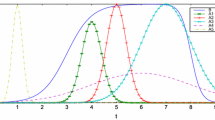Abstract
The association rule based classification is imperative in the disease prediction owing to its high predictability. To deal with the sensitive data, we propose an algorithm using fuzzy inference set. The association rule mining is improved further by generating an associative rules for each item of the data set. The ranking of the item in the data set is based on the information mass value estimated. The mass value represents the depth of the item in the data set and its class. Selection of the certain item set is done based on the mass value of different associated items. According to the associative items selected, the association rule mining is performed. For each association rule generated, this method calculates the impact of each object from the rules based on how fuzzy rules are generated. Fuzzy impact rules indicate symptoms and diagnostic labels. A class of disease posses disease influence measure that predicts each class of disease has changed. The proposed algorithm improves the classification efficiency and reduces the error rates.







Similar content being viewed by others
Change history
04 July 2022
This article has been retracted. Please see the Retraction Notice for more detail: https://doi.org/10.1007/s12652-022-04281-2
References
Abaya SA (2012) Association rule mining based on apriori algorithm in minimizing candidate generation. IJSER 3(7):1–4
Ansarullah SI (2016) Heart disease prediction system using data mining techniques. Int Res J Eng Technol (IRJET) 56(3):109–113
Bose S, Datta S (2015) Frequent pattern generation in association rule mining using weighted support. In: IEEE conference on computer, communication, control and information technology (C3IT)
Kavakiotis I, Tzanis G, Vlahavas I (2014) Mining frequent patterns and association rules from biological data. In: Biological knowledge discovery handbook: preprocessing, mining and postprocessing of biological data, chap 34. Bioinformatics: computational techniques and engineering
Kavakiotisa I (2017) Machine learning and data mining methods in diabetes research. J Comput Struct Biotechnol 15:104–116
Kawano S et al (2012) identifying gene pathways associatedwith cancer characteristics viasparse statistical methods. IEEE/ACM Trans Comput Biol Bioinform 9(4):966–972
Kirmani MM (2017) Cardiovascular disease prediction using data mining techniques. Orient J Comput Sci Technol 10(2):520–528
Komi M, Li J, Zhai Y, Zhang X (2017) Application of data mining methods in diabetes prediction. In: IEEE conference on image, vision and computing (ICIVC)
Lan W (1999) Predicting microRNA–disease associations based on improved microRNA and disease similarities. IEEE/ACM Trans Comput Biol Bioinform 15(6):1774–1782
Li J, Su H, Chen H, Futscher BW (2007) Optimal search-based gene subset selection for gene array cancer classification. IEEE Trans Inf Technol Biomed 11(4):398–405
Maji P, Das C (2012) Relevant and significant supervised gene clusters for microarray cancer classification. IEEE Trans Nanobiosci 11(2):161–168
Maulik U, Mukhopadhyay N, Chakraborty D (2013) Gene-expression-based cancer subtypes prediction through feature selection and transductive SVM. IEEE Trans Biomed Eng 60(4):1111–1117
Purusothaman G, Krishnakumari P (2015) A survey of data mining techniques on risk prediction: heart disease. Ind J Sci Technol 8(12):1–5
Santhanam T, Ephzibah EP (2015) Heart disease prediction using hybrid genetic fuzzy model. Ind J Sci Technol 8(9):797–803
Sathishkumar EN, Thangavel K, Chandrasekha T (2013) A novel approach for single gene selection using clustering and dimensionality reduction. Int J Sci Eng Res 4(5):1540–1545
Shao Z, Li Y, Wang X et al (2020) Research on a new automatic generation algorithm of concept map based on text analysis and association rules mining. J Ambient Intell Hum Comput 11:539–551. https://doi.org/10.1007/s12652-018-0934-9
Tsai C-A et al (2004) Gene selection for sample classifications in microarray experiments. DNA Cell Biol 23(10):607–614
Worachartcheewan A, Nantasenamat C, Isarankura-Na-Ayudhya C, Prachayasittikul V (2013) Quantitative population—health relationship (QPHR) for assessing metabolic syndrome. EXCLI J 12:569–583
Author information
Authors and Affiliations
Corresponding author
Additional information
Publisher's Note
Springer Nature remains neutral with regard to jurisdictional claims in published maps and institutional affiliations.
This article has been retracted. Please see the retraction notice for more detail: https://doi.org/10.1007/s12652-022-04281-2
About this article
Cite this article
Dhanalakshmi, R., Anitha, K., Rukmani Devi, D. et al. RETRACTED ARTICLE: Association rule generation and classification with fuzzy influence rule based on information mass value. J Ambient Intell Human Comput 12, 6613–6620 (2021). https://doi.org/10.1007/s12652-020-02280-9
Received:
Accepted:
Published:
Issue Date:
DOI: https://doi.org/10.1007/s12652-020-02280-9




